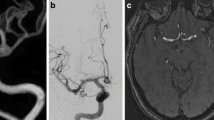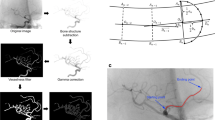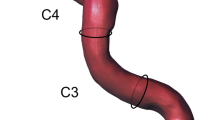Abstract
To elucidate the three-dimensional structure of the anterior communicating artery complex, we performed three-dimensional digital subtraction angiography in anterior communicating (Acom) aneurysm cases. Eighteen patients (six male and 12 female) with Acom aneurysms were studied. The total number of aneurysms was 18, of which three were unruptured and 15 were ruptured. Aneurysmal sizes and angles between the parent artery and each of the two daughter arteries were measured. Two types were defined, based on the daughter arteries. When the sizes of the two daughter arteries were the same, they were defined as AA’ type, and when different, they were defined as AB type. Furthermore, aneurysms were classified into two types based on neck location. Thus, when the neck was located on the extension of the midline of the parent artery, it was defined as classical neck type, and when it was not, it was defined as deviating neck type. There were 11 cases of AA’ type and seven of AB type. In AA’ type all cases were of the classical neck type, and in AB type three cases were of the classical neck type and three were of the deviating neck type. In the deviating neck type, the necks were deviated to the smaller daughter arteries in all cases.







Similar content being viewed by others
References
Gauvrit JY, Leclerc X, Vermandel M, et al (2005) 3D rotational angiography: use of propeller rotation for the evaluation of intracranial aneurysms. AJNR Am J Neuroradiol 26:163–165
Hashimoto N, Handa H, Nagata I, Hazama F (1983) Saccular cerebral aneurysms in rats. Am J Pathol 110:397–399
Hashimoto N, Kim C, Kikuchi H, Kojima M, Kang Y, Hazama F (1987) Experimental induction of cerebral aneurysms in monkeys. J Neurosurg 67:903–905
Hirai T, Korogi Y, Suginohara K, et al (2003) Clinical usefulness of unsubtracted 3D digital angiography compared with rotational digital angiography in the pretreatment evaluation of intracranial aneurysms. Am J Neuroradiol 24:1067–1074
Kang HS, Han MH, Kwon BJ, et al (2004) Postoperative 3D angiography in intracranial aneurysms. Am J Neuroradiol 25:1463–1469
Kitami K, Kamiyama H, Yasui N (1985) Angiographic analysis of the anterior cerebral arteries with cerebral aneurysms—with special interest in the morphological aspect including so-called vascular anomalies. No Shinkei Geka 13:1161–1167
Locksley HB (1966) Report on the cooperative study of intracranial aneurysms and subarachnoid hemorrhage: section V. J Neurosurg 25:219–239
Sadatomo T, Yuki K, Migita K, Taniguchi E, Kodama Y, Kurisu K (2005) Evaluation of relation among aneurysmal neck, parent artery and daughter arteries in middle cerebral artery aneurysms by three-dimensional digital subtraction angiography. Neurosurg Rev 28:196–200
Stehbens WE (1963) Histopathology of cerebral aneurysms. Arch Neurol 8:272–285
Stehbens WE (1983) Etiology and pathogenesis of intracranial berry aneurysms. In: Fox JL (ed) Intracranial aneurysms, vol 1. Springer, New York, pp 358–395
Tanoue S, Kiyosue H, Kenai H, et al (2000) Three-dimensional reconstructed images after rotational angiography in the evaluation of intracranial aneurysms: surgical correlation. Neurosurgery 47:866–871
Ture U, Yasargil MG, Krisht AF (1996) The arteries of the corpus callosum: a microsurgical anatomic study. Neurosurgery 36:1075–1085
Ujiie H, Tamano Y, Sasaki K, Hori T (2001) Is the aspect ratio a reliable index for predicting the rupture of a saccular aneurysm? Neurosurgery 48:495–503
Weir B, Amidei C, Kongable G, Findlay JM, Kassell N, Kelly J, Dai L, Karrison TG (2003) The aspect ratio (dome/neck) of ruptured and unruptured aneurysms. J Neurosurg 99:447–451
Yasargil MG (1984) Microneurosurgery II. Clinical considerations, surgery of the intracranial aneurysms and results. In: Anterior cerebral and anterior communicating artery aneurysms, vol 4. Thieme Stratton, New York,pp 165–231
Author information
Authors and Affiliations
Corresponding author
Rights and permissions
About this article
Cite this article
Sadatomo, T., Yuki, K., Migita, K. et al. The characteristics of the anterior communicating artery aneurysm complex by three-dimensional digital subtraction angiography. Neurosurg Rev 29, 201–207 (2006). https://doi.org/10.1007/s10143-006-0025-9
Received:
Revised:
Accepted:
Published:
Issue Date:
DOI: https://doi.org/10.1007/s10143-006-0025-9




